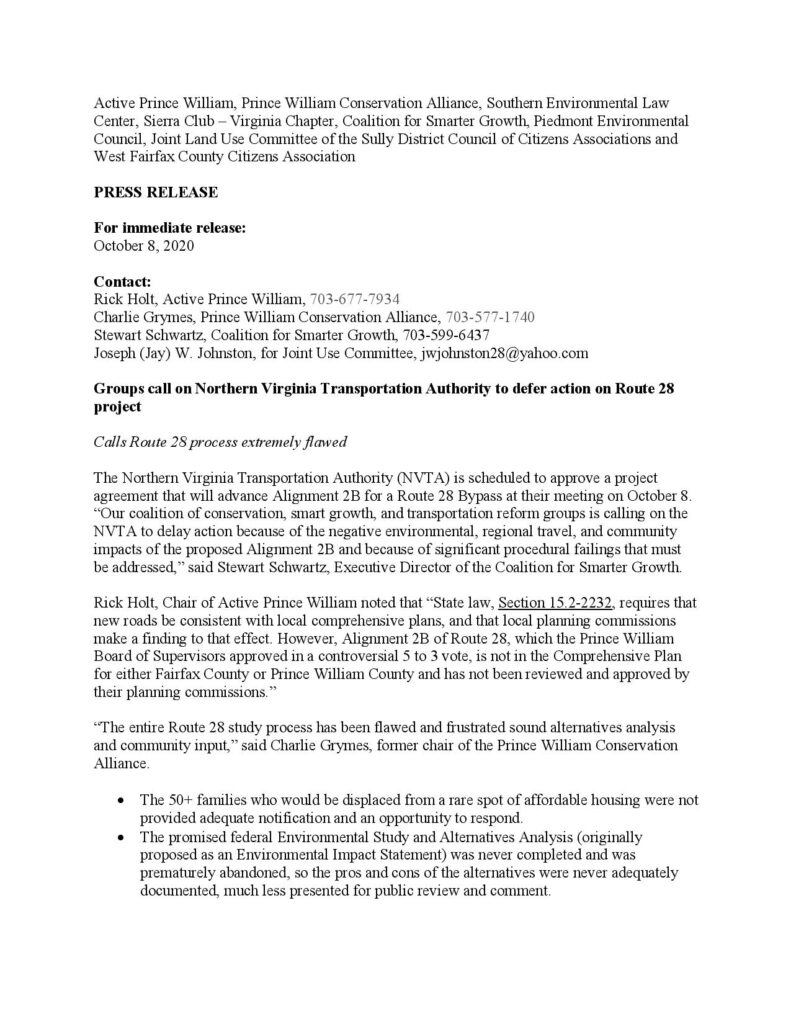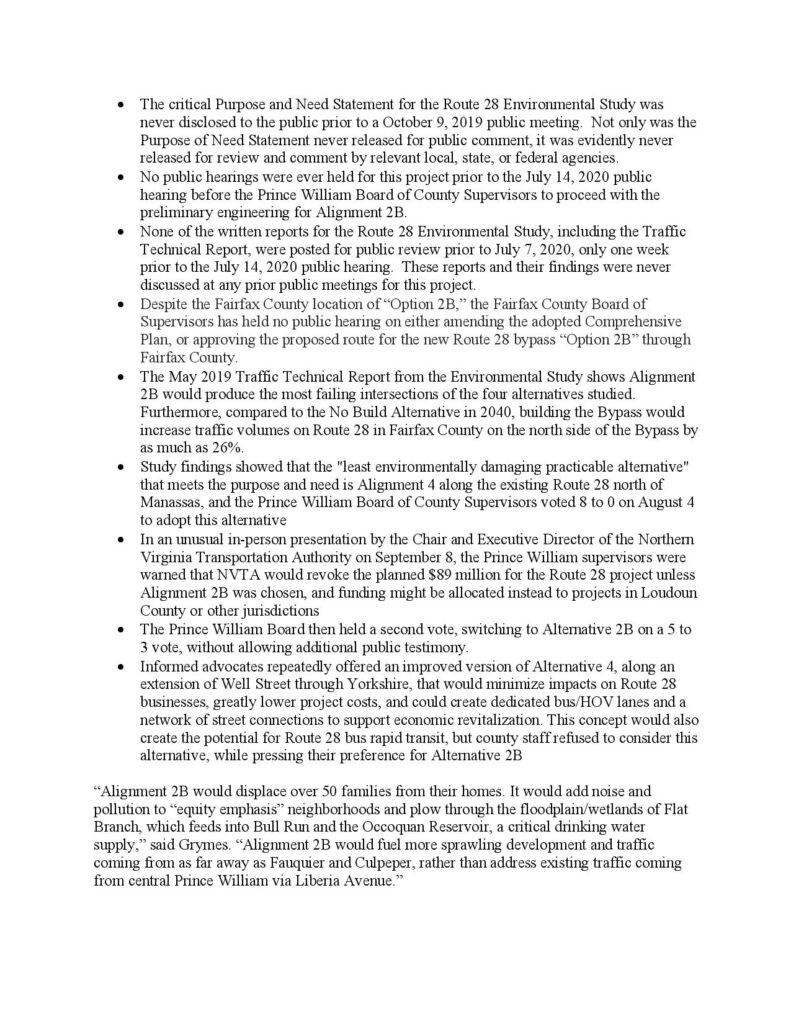Press Release
For immediate release:
December 16, 2020
Contact:
Stewart Schwartz, CSG, 703-599-6437
Historic climate vote took place today at Metropolitan Washington’s Transportation Planning Board (TPB)
Elected officials agree to prioritize transportation projects and policies to reduce greenhouse gas emissions
Today, at the launch of the process to create the Washington DC region’s next multi-billion dollar regional transportation plan, Visualize2045, elected officials on the Transportation Planning Board (TPB) voted to “[require] (emphasis added) its member agencies to prioritize investments on projects, programs, and policies to reduce greenhouse gas emissions, prioritize the aspirational strategies, and achieve COG’s land use and equity goals as they submit their input for inclusion in the TPB’s [Long-Range Transportation Plan and Transportation Improvement Program].” The TPB also agreed to prioritize the aspirational initiatives they adopted in early 2018 including linking jobs and housing, a regional bus rapid transit network, Metro, demand management, bike/walk access to transit, and the capital region trail network.
“This is a historic vote. For the first time, regional elected officials committed to prioritizing transportation projects, programs, and plans to reduce greenhouse gas emissions through the region’s transportation plan,” said Stewart Schwartz, Executive Director of the Coalition for Smarter Growth (CSG). “They also agreed on the need to reduce vehicle miles traveled to achieve the greenhouse gas emissions reductions we need.”
During the debate, representatives of Prince William and Loudoun counties raised concerns about the challenges of reducing VMT in outer suburbs, and sought to soften the resolution from “requires” to “urges.” Their motion failed, and the vote on the full package of amendments passed 22 to 1 with 7 abstentions and 6 members absent. A full list of elected officials’ votes can be found below.
“In response to the concerns of the outer suburbs,” Schwartz said, “we believe that the outer suburbs can help tackle transportation emission, through better land use including walkable, mixed-use ’15-minute’ neighborhoods, commuter rail, and bus.”
The TPB’s action follows the commitment by the Council of Governments to reduce the region’s total greenhouse gas emissions 50% below 2005 levels by 2030.
“Our analysis shows that adoption of electric vehicles is essential, but the timeline is uncertain, and we’ll have to do more – which means reducing how much we have to drive, through better land use – walkable, transit-oriented communities; addressing the east-west jobs imbalance; and investing more in transit, walking and biking infrastructure,” said Bill Pugh, Senior Policy Fellow for CSG. Bill’s analysis for CSG is laid out in his recent post in Greater Greater Washington, and in a draft paper – Cutting Transportation Emissions by 2030 and Beyond: Smart Land Use and Travel are Essential submitted to the Transportation Planning Board by CSG.
THE VOTES:
Here is how Transportation Planning Board members voted on amendments to strengthen commitments to reducing vehicle miles traveled and greenhouse gas emissions (the full Technical Solicitation document can be found at a link here and amendments debated today can be found at Agenda Item 9; official vote tally should be confirmed with TPB staff).
Motion by Loudoun County Supervisor Kristen Umstattd, seconded by Manassas Park Vice-Mayor Pamela Sebesky to “urge” rather than “require” that jurisdictions prioritize projects, programs, and policies to reduce greenhouse gas emissions.
“Through this technical solicitation input process the TPB urges/requires its member agencies to prioritize investments on projects, programs, and policies to reduce greenhouse gas emissions, prioritize the aspirational strategies, and achieve COG’s land use and equity goals as they submit their input for inclusion in the TPB’s [Long-Range Transportation Plan and Transportation Improvement Program].”
Motion failed with 16 no, 14 yes (with 6 members absent)
Voting yes (for “urges”)
1. DDOT represented by Mark Rawlings
2. MDOT represented by Asst Secretary Jeffrey Hirsch
3. Charles County – Jason Groth (staff)
4. City of Frederick Alderman Kelly Russell (TPB 2020 Chair)
5. City of Laurel – represented by staff Phil Goddard (?)
6. Virginia Department of Transportation
7. Fairfax County Supervisor Walter Alcorn
8. Fairfax County Supervisor James Walkinshaw
9. Loudoun County Supervisor Kristen Umstattd
10. Loudoun County staff representative Bob Brown
11. City of Manassas Vice-Mayor Pamela Sebesky
12. City of Manassas Park Mayor Jeanette Rishell
13. Prince William County Chair Ann Wheeler
14. Prince William County Board Member Victor Angry
Voting no (favoring “requires”)
1. DC Office of Planning – Kristin Caulkins
2. DC Councilmember Charles Allen
3. College Park Councilmember Denise Mitchell
4. Frederick County Alderman Kai Hagen
5. City of Greenbelt – Mayor Emmett Jordan
6. Montgomery County Executive – represented by Gary Erenrich
7. Montgomery County Councilmember Evan Glass
8. Prince George’s Councilmember Deni Tavares
9. City of Rockville Mayor Bridget Newton
10. City of Takoma Park Councilmember Kacey Kostiuk
11. Maryland Delegate Carol Krimm
12. City of Alexandria Councilmember Canek Aguirre
13. Arlington County Board member Christian Dorsey
14. City of Fairfax Mayor David Meyer
15. City of Falls Church Councilmember David Snyder
16. WMATA represented by Shyam Kannan
Absent:
1. DC Councilmember Phil Mendelson
2. DC Councilmember Brandon Todd
3. City of Bowie
4. City of Gaithersburg
5. Prince George’s County Executive represented by Victor Weissberg (Dept of Transportation)
6. Fauquier County
Motion to adopt all six amendments (found at Agenda item 9) first proposed by Falls Church Councilmember David Snyder with final drafting by TPB staff including amendment B with “requires.” Motion made by Mayor Bridget Newton of the City of Rockville and seconded by Councilmember Charles Allen of DC.
Motion passed with 22 yes, 1 no, 7 abstentions (with 6 members absent)
Yes (for the amendments on VMT and greenhouse gas emissions)
1. DC Office of Planning – Kristin Caulkins
2. DC Councilmember Charles Allen
3. MDOT represented by Asst Secretary Jeffrey Hirsch
4. College Park Councilmember Denise Mitchell
5. Frederick County Alderman Kai Hagen
6. City of Frederick Alderman Kelly Russell (TPB 2020 Chair)
7. City of Greenbelt – Mayor Emmett Jordan
8. City of Laurel – represented by staff Phil Goddard (?)
9. Montgomery County Executive – represented by Gary Erenrich
10. Montgomery County Councilmember Evan Glass
11. Prince George’s County Executive represented by Victor Weissberg (Dept of Transportation)
12. Prince George’s Councilmember Deni Tavares
13. City of Rockville Mayor Bridget Newton
14. City of Takoma Park Councilmember Kacey Kostiuk
15. Maryland Delegate Carol Krimm
16. City of Alexandria Councilmember Canek Aguirre
17. Arlington County – Dan Malouff for Board member Christian Dorsey
18. City of Fairfax Mayor David Meyer
19. City of Falls Church Councilmember David Snyder
20. Fairfax County Board Member Walter Alcorn
21. Fairfax County Board Member James Walkinshaw
22. WMATA represented by Shyam Kannan
No
1. Virginia Department of Transportation
Abstentions
1. DDOT represented by Mark Rawlings
2. Loudoun County Supervisor Kristen Umstattd
3. Loudoun County staff representative Bob Brown
4. City of Manassas Vice-Mayor Pamela Sebesky
5. City of Manassas Park Mayor Jeanette Rishell
6. Prince William County Chair Ann Wheeler
7. Prince William County Board Member Victor Angry
Absent:
1. DC Councilmember Phil Mendelson
2. DC Councilmember Brandon Todd
3. City of Bowie
4. City of Gaithersburg
5. Fauquier County
6. Charles County
###
The Coalition for Smarter Growth advocates for walkable, bikeable, inclusive, and transit-oriented communities as the most sustainable and equitable way for the Washington, DC region to grow and provide opportunities for all.




